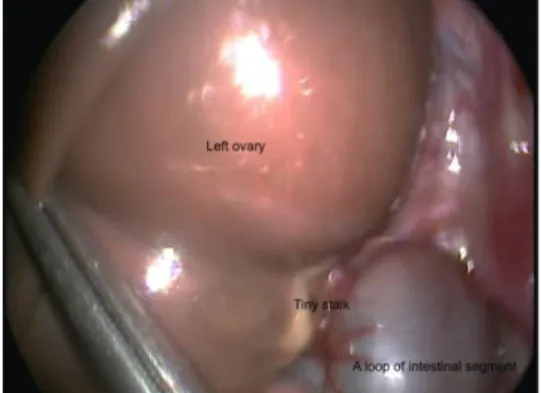Journal of Neonatal Surgery 2016; 5(1):7
EL-MED-Pub Publishers.
* Corresponding Author
C
ASE REPORT
Laparoscopic Management of Synchronous Bilateral Ovarian Torsion
in a Neonate
Murat Alkan1,* Ali Elbek2, Cuneyt Evruke3, Ahmet Eray Memec4, Bulent Aziz Ozkan5, Hatice Gülin Sucak6, Ozgur Talat Erkan7
1 Department of Pediatric Surgery, Division of Pediatric Urology, Cukurova University, Faculty of Medicine, Adana, Turkey 2 Department of Pediatric Surgery, Medline Adana Hospital, Adana, Turkey
3 Department of Obstetrics and Gynecology, Cukurova University, Faculty of Medicine, Adana, Turkey 4 Department of Obstetrics and Gynecology, Medline Adana Hospital, Adana, Turkey 5 Department of Pediatrics and Neonatology, Medline Adana Hospital, Adana, Turkey
6 Department of Radiology, Medline Adana Hospital, Adana, Turkey 7 Department of Anesthesiology, Medline Adana Hospital, Adana, Turkey
This is an open-access article distributed under the terms of the Creative Commons Attribution License, which permits unrestricted use, distribution, and reproduction in any medium, provided the original work is properly cited.
ABSTRACT
Synchronous bilateral ovarian torsion is an uncommon entity of which both ovaries twist at the same time or observed twisted during the surgical intervention. Herein, we present a neonate with bilateral ovarian torsion, which successfully managed by laparoscopic approach.
Key words:Synchronous, Bilateral ovarian torsion, Neonate
CASE REPORT
A neonate born at term to a 26-year-old primi-gravida by elective cesarean delivery was diag-nosed with an intra-abdominal cystic mass at 35th week of pregnancy. A conservative management plan was undertaken with re-peated ultrasonographic evaluations every two weeks. The pregnancy, medical history of the patient and birth were unremarkable. A female full-term infant of 39+5 week of gestation was delivered with a birth weight of 4160 gram. Physical examination was unremarkable. Post-delivery ultrasonography revealed an anechoic uncomplicated cystic mass measuring 5x3.5 cm located in the right pelvis and another semi-solid complicated cystic mass was located in the left pelvis with a measure of 5.4x3.8 cm, without any vascular signal. Both ovaries were not identified.
Laparoscopy revealed brown round smooth cystic mass with a tiny stalk nearly amputated from the left fallopian tube in the left pelvis. A loop of intestinal segment also twisted around this calcified tiny stalk of the mass (Fig. 1). Right ovary was also twisted with the cystic mass (Fig. 2). The right ovary was untwisted 2 times (360 degree) and left in the pelvis after cyst aspiration without excision and ovarian fixation. Then the left ovary examined and seemed to be nearly amputated from the ad-nexa. It was removed after cyst aspiration. The calcified stalk was separated from the bowel. The post-operative period was uneventful and the patient was discharged on the 2nd post-operative day. Follow-up at 1 month with ultrasonographic evaluations showed an18 mm right ovary and no cyst.
Laparoscopic Management of Synchronous Bilateral Ovarian Torsion in a Neonate
Journal of Neonatal Surgery Vol. 5; 2016 Figure 1: A loop of intestinal segment twisted around
the calcified stalk of the left brownish ovarian cyst.
Figure 2: Twisted right ovarian cyst.
DISCUSSION
The differential diagnosis of a prenatal cystic abdominal mass includes omental cyst, mesen-teric cyst, intestinal duplication, urachal cysts, renal cysts and ovarian cysts [1]. Preoperative diagnosis of ovarian torsion is difficult not only in newborns or infants but also in pre pubertal girls. The etiology of the ovarian cysts during pregnancy is related to the immature hypothalamus-pituitary-ovarian feedback that results gonadal hyperstimulation or placental insufficiency with incomplete maturation of the gonadostat. There are few reported patients of
asynchronous bilateral adnexal torsion in chil-dren in the literature [2, 3]. Synchronous bilat-eral ovarian torsion has also been reported which was successfully managed by laparo-scopic detorsion [4].
When a post-natal radiological evaluation re-veals a complicated ovarian cyst, irrespective of the size, surgical management recommended either by laparoscopy or laparotomy [5]. Uncomplicated cysts, smaller than 5 cm diame-ter usually resolve spontaneously while the cysts exceeding 5 cm should be decompress via aspiration to prevent complications [6]. This case highlights the importance of high index of suspicion and early diagnosis of bilateral ovar-ian torsion in the newborn with bilateral pelvic cysts detected on the pre-natal and post-natal scans.
REFERENCES
1. Mahomed A, Jibril A, Youngson G. Laparoscopic management of a large ovarian cyst in the neonate. Surg Endosc. 1998; 10:1272-4.
2. Ozcan C, Celik A, Ozok G, Erdener A, Balik E. Adnexal torsion in children may have a catastrophic sequel: asynchronous bilateral torsion. J Pediatr Surg. 2002; 11:1617-20.
3. Dunnihoo DR, Wolff J. Bilateral torsion of the adnexa: a case report and a review of the world literature. Obstet Gynecol. 1984; 3:55-9.
4. Munshi S, Patel A, Banker M, Patel P. Laparoscopic detorsion for bilateral ovarian torsion in a singleton
pregnancy with spontaneous ovarian
hyperstimulation syndrome. J Hum Reprod Sci. 2014; 1:66-8.
5. Templeman CL, Reynolds AM, Hertweck SP, Nagaraj HS. Laparoscopic management of neonatal ovarian cysts. J Am Assoc Gynecol Laparosc. 2000; 3:401-4. 6. Mittermayer C, Blaicher W, Grassauer D, Horcher E,
Deutinger J, Bernaschek G, et al. Fetal ovarian cysts: development and neonatal outcome. Ultraschall Med. 2003; 1:21-6.
Address for Correspondence*:
Murat Alkan, Department of Pediatric Surgery, Division of Pediatric Urology, Cukurova University, Faculty of Medicine, Adana, Turkey
E mail: jkmahajan@gmail.com © 2016, Journal of Neonatal Surgery Submitted: 10-11-2015
Accepted: 21-11-2015 Conflict of interest: None Source of Support: Nil
How to cite: Alkan M, Elbek A, Evruke C, Memec AE, Ozkan BA, Sucak HG, et al. Laparoscopic management of synchronous bilateral ovarian torsion in a neonate. J Neonat Surg. 2016; 5:7.
